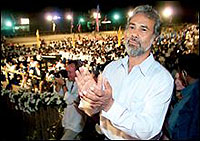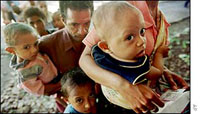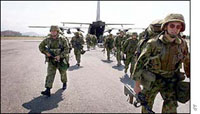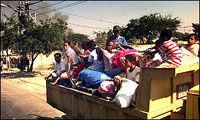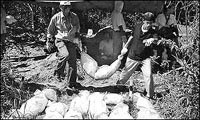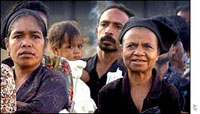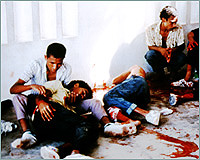EAST TIMOR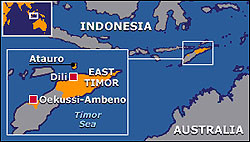
(Created by Judith R. Ward, History 135, August 2002) How did events that occurred
in East Timor prior to its independence determine the
issues that faced the new country, or How did East Timor's historical legacy affect its
independence?
Return to top East
Timor occupies one half of a small, mountainous island located approximately
400 miles north of Australia. Discovered by the Portuguese around
1515, the island was exploited for its sandalwood.
The Portuguese occupation had little effect on the local population until a Catholic mission was established by Dominican friars in the late 1500s. Portuguese culture spread as soldiers, sailors and traders settled on the island and intermarried. The Dutch arrived in western Timor in the 17th century and challenged Portuguese dominance. European powers fought for the next two centuries over control of Timor until 1850 when a diplomatic accord was reached. The western half of the island was formally incorporated into the Dutch East Indies and eventually became part of the Republic of Indonesia. The eastern half remained an overseas colony of Portugal. Portugal had a diminishing influence in East Timor as the sandalwood trade dwindled; the colony was an economic drain on Portugal's economy. Following World War II there was an international movement to return sovereignty to overseas holdings, but Portugal, governed by the dictatorship of General Salazar, was slow to grant independence to overseas colonies, holding on to hopes that East Timor could become economically viable and provide revenues to the mother country. However, with Salazar's ousting in 1974, and a troubled economy, Portugal pulled out of East Timor, leaving the country to fend for itself. With the departure of the Portuguese, various political factions gained footholds in East Timor, but there was little organization and no single body provided the necessary unified leadership. Indonesia was quick to step in. Implicitly given the go-ahead by the United States during a visit to Indonesia by President Gerald Ford and Secretary of State Henry Kissinger in early December 1975, Indonesia invaded East Timor days later, on December 7, 1975. The Indonesian military, outfitted by the United States, received ever increasing military aid (in the form of equipment and training) during the occupation of East Timor. Ostensibly for peacekeeping purposes only, military aid from the United States was provided in large part because of a US fear of communist dominance in Southeast Asia. It was expedient for the United States to ignore the situation in East Timor. The Timorese resistance party, FREITLIN (Revolutionary Front for an Independent East Timor), seen as pro-communist by the United States, led the pro-independence movement. Widespread violence resulting in massive death tolls continued until 1999. Estimates place Timorese deaths in the period between 1975 and 1999 as high as 200,000 out of a total population of only 690,000. Through the efforts of the Timorese people, various aid groups and the media, the plight of East Timor came to international attention. The ousting of Indonesian "reign of terror" President Suharto provided impetus for a shift in policy towards East Timor as Indonesia was faced with its own numerous internal problems. But the concessions by Indonesia were not deemed significant enough by the resistance forces in East Timor. Talks between Indonesia and Portugal resulted in the 5 May 1999 signing of an agreement allowing the East Timorese to decide by referendum the issue of incorporation into Indonesia or independence. The United Nations agreed to oversee the balloting to ensure a fair process. On August 30, 1999, the Timorese people voted overwhelmingly for independence from Indonesia. Backlash by pro-Indonesian militia troops was swift and violent, as they rampaged through the country, killing and pillaging. Finally, admitting a loss of control, Indonesia agreed to admit an Australian-led United Nations international peacekeeping force. On 20 September 1999, the first United Nations troops arrived to begin the process of restoring peace and moving East Timor forward toward full independence. On October 18, 1999, Indonesia officially endorsed the vote for independence and declared the previous annexation of East Timor null and void. The last Indonesian troops left East Timor on November 1, 1999, following the establishment of the United Nations Transitional Administration (UNTAET) on October 25, 1999. UNTAET assisted the East Timorese in rebuilding their ransacked country and the first parliamentary elections were held on August 30, 2001. Plans proceeded to hand over full responsibility for independent governance as the newly seated parliament crafted a constitution and organized presidential elections. Presidential elections held on April 14, 2002, resulted in the victory of resistance leader Xanana Gusmao as president. At midnight on May 19, 2002, East Timor became the world's newest nation. Return to top
Return to top
Capital: Dili
Population: 738,000 (estimate) 
Per Capita GDP: $478
Economic Growth: -40% (1999-2000); +18-20% (2000-2001); expected to stabilize at 6% per year Population below Poverty Line: 41% Political System: Constitutional parliamentary democracy with president as head of state President: Jose 'Xanana' Gusmao Chief Minister: Mari Alkatiri Religion: Majority Roman Catholic Official Languages: Portuguese, Tetum Other Languages: Indonesian, English Average Life Expectancy: 57 years Literacy Level: Less than 50 percent Major Aid Donors: Japan, Australia, United States, European Union Major Investors: Singapore, Indonesia, Australia Return to top Much of
the most up-to-date information on East Timor is located on the web. With significant
events occurring daily, it is difficult for any traditional published media
to keep with events. In fact, the web may in part be responsible for the
widespread international interest in East Timor. Without the web, East Timor
would probably been just another colonial casualty of a larger power (in this case
Indonesia). There are a number of excellent web sites, both commercial and
official. Some of the best are:
BBC News offers two related sites: BBC Asia-Pacific News provides up-to-date information about news in East Timor as well as events in neighboring countries; BBC News-East Timor provides in-depth coverage of events specific to East Timor. ABC News also provides a comprehensive site with coverage specific to East Timor at ABC Asia-Pacific News. CNN's news site contains a wealth of information, including audio and video clips of breaking news in East Timor, CNN Asia (Special Report). The East Timor Government Site has been under construction since the United Nations handed over governmental control on May 20, 2002. However, it is under continual revision even as it is being created and should be a valuable site once it is up and running. The PBS Online Newshour with Jim Lehrer has provided coverage of the period prior to independence, but not current coverage. A publication of Timor Aid, Timor Today, ceased publication in September 2001. However it provides links to a variety of historical documents related to the United Nations Transitional Administration in East Timor. Easttimor.com has coverage of breaking news related to East Timor. It is an easy site to use and does not contain the sometimes distracting advertising of other major news sites. There are links to historical documents (East Timor's constitution), as well as in-depth reports and links to discussion groups. East Timor Action Network (ETAN) has a couple of sites. One is devoted exclusively to the role of women in East Timor and has links to related articles and documents. The main site, Etan.org is a political site to promote the cause of Timorese independence as well as justice. There are suggestions for letter-writing campaigns to the U.S. House of Representatives and the U.S. Senate. There are also links to the final version of East Timor's constitution. Legends from Timor is an interesting site that has links to traditional tales from East Timor. UNTAET Daily Timor Briefings has links to all daily briefings of the United Nations Transitional Administration. Finally, Yahoo!News has links to breaking news stories from a variety of sources. There are also multiple links to related sites. Also:
Most of
what has been written about East Timor has appeared only since the late 1990s. There
has been an upsurgence of interest in this small country since the
violence following the vote for independence in 1999. While most
local libraries do not carry the following books, most are available
from Amazon.com, or other booksellers, at reasonable prices (especially
for used copies). Several excellent books are the following:
Carey, P. and Bentley, G. C. (Editors). East Timor at the Crossroads: The Forging of a Nation. Social Science Research Council, 1995. This book contains articles pertaining to the history of East Timor as well as information about the fight for independence and future scenarios. It was the most comprehensive of the books available on East Timor, covering a large time period (from prehistory through colonialism to scenarios for the future). Cristalis, I. Bitter Dawn: East Timor, A People's Story. Zed Books, 2002. This book, while not officially published, has recently become available in advance reading copies. It was originally due out in June 2002 but has been postponed to September 2002. Although this book was not reviewed for this project, it should prove to be a valuable resource, filling in the gaps between the vote for independence (1999) and independence day (5/20/02). Jardine, M. East Timor: Genocide in Paradise, 2nd Edition. Odonian Press, 1999. Martin, I. Self-Determination in East Timor: The United Nations, the Ballot, and International Intervention. Lynne Rienner Publishers, 2001. Documenting the events of 1999 which included the ballot for independence and the violence that followed, this book contains the perspective of the United Nations Transitional Administration. Pinto, C. and Jardine, M. East Timor's Unfinished Struggle: Inside the Timorese Resistance -- A Testimony. South End Press, 1997. The Timorese struggle for independence is told through the eyes of Constancio Pinto, a resistance leader against the Indonesian occupation. There are vivid descriptions of the violence that followed the vote for independence as well as a review of the background to the struggle. Return to top |
